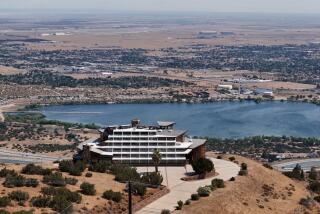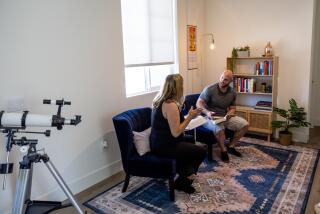Developer Gives in to Market Gone Sour : Real estate: When few buy into his country club for the rich, a local billionaire tries to make his Lake Sherwood homes more affordable.
- Share via
Conceived as a community of weekend estates for the rich and famous, billionaire David H. Murdock’s oak-studded Sherwood Country Club has now made its own painful concessions to a real estate market gone sour.
Murdock dug more than $200 million from his own deep pockets to build the best houses in the best climate on the best new golf course that money could buy an hour from downtown Los Angeles.
Admirers praised Sherwood’s classic architectural designs, but never bought into Murdock’s dream. Nor did the billionaire’s neighbors in Bel-Air embrace the idea of weekends near Thousand Oaks.
Murdock himself acknowledges a vision that was flawed from the start.
“It didn’t happen at all,” Murdock, 71, said one recent warm afternoon over iced tea at the red-brick, white-columned tennis club at Sherwood. “We were told at the beginning that (home buyers) would prefer to come on weekends and play golf and tennis. But we haven’t found those people. I don’t think we have any old wealth here.
“Ventura, while it is a maturing county, is not a county for super wealth,” he added. “We found we had to cut the very expensive things I was putting in the houses, because they were overpriced.”
So Murdock, confronted by a wrenching miscalculation, began to change his community--planned for 630 homes--to match the market.
Larger houses on prime parcels now sell for $1.5 million, instead of $3 million. Floors are still mahogany, fireplaces are still marble, roofs are still Chinese slate. But the elaborate woodworking and silk wallpaper are gone.
And in his greatest concession, Murdock decided to sell two sets of homes--condominiums inside Sherwood’s heavy metal gates and lake-view houses outside of them--for as little as $500,000 to increase buyer traffic.
He recently petitioned the Ventura County Planning Commission for the second time to expand a cluster of stylish hillside condominiums that range in size from 2,000 to 3,000 square feet and cost $500,000 to $675,000. Once, 32 condos were planned there. Now 75 are allowed.
“My associates in sales have had a strong influence on my decisions,” Murdock concedes. “The public wants what they want, not what I want.”
Thanks to 27 escrows this year, Sherwood’s total house sales have jumped to 56, plus eight vacant lots. And Murdock, a corporate takeover specialist who is chairman of Dole Food Co., said he thinks he has found a way to win his costly Sherwood gamble.
“We are beginning to have something we did not have before--friends telling their friends what they have here,” he said. “Success begats success. . . . Motion begats motion.”
It has been nearly five years since Murdock unveiled his man-made paradise at Lake Sherwood on national television as top golfers, framed against a classic Georgian clubhouse, competed in Greg Norman’s first Shark Shootout.
In those exuberant days, the country club was said to have a waiting list of 2,600 for just 300 golf memberships, despite a price of $150,000 for home buyers and $225,000 for non-residents. Annual dues are $6,000 more.
But today, only 140 golfers hold full memberships, excluding honorary members such as former Presidents George Bush, Ronald Reagan and Gerald Ford.
Forty more people belong to the Sherwood Tennis Club, which sponsors a senior tour tournament hosted by Jimmy Connors. But the cost of joining the club has been cut from $40,000 to $25,000.
“It’s just a response to the market,” Murdock said.
Not that 1,900-acre Sherwood is just another pricey subdivision.
It sits at the east end of Hidden Valley, whose towering oak trees, white-fenced pastures and mountain backdrops have beckoned the moneyed of Southern California for decades.
Murdock raises Arabian horses and Santa Gertrudis cattle at his 2,000-acre Ventura Farms directly across Potrero Road from Sherwood. Richard Widmark and Sophia Loren have ranches nearby.
And the membership of Sherwood Country Club is bolstered by Hidden Valley ranch owner-actors Tom Selleck and Robert Wagner, both members of the club’s board of governors. Arco Chairman Lodwrick Cook is also on the board, as is Ed Hogan of Pleasant Hawaiian Holidays.
The main clubhouse--60,000 square feet of dark wood and formality--is more old England than modern America. The golf course, designed by Jack Nicklaus, is ranked among the nation’s top 80 by Golf Digest magazine.
In the locker room, even showers are marble and their doors mahogany. One cubicle holds lockers not only for the three former presidents, but also for actors Selleck, Wagner and Jack Nicholson and athletes Nicklaus, Norman and Brett Saberhagen.
Bush and Reagan, and their Secret Service entourage, once helicoptered in for a round of golf.
Motion picture executives are members. So are Wayne Gretzky and O.J. Simpson, who discovered that strict club rules are binding when he was asked to change from shorts to slacks before teeing off.
Whites are required at the tennis club, which boasts a 1,000-year-old oak tree, hosts championship croquet and is said to be the only club in the region with clay, grass and hard court surfaces.
Those uncompromising touches--and elegant model homes that reached back to colonial Georgia and ancient Greece for inspiration--created the feel of exclusivity originally intended to sell Sherwood, but which has now begun to change out of necessity.
“I think Sherwood paid its dues in a marketing sense,” publicist Brooks Roddan said. “When they opened it up it was sort of David Murdock’s private kingdom, sort of an adult Disneyland. But it also had a ‘don’t touch me’ exclusivity that has been overcome.”
Instead of rich weekenders seeking solitude and security in a country setting, its residents have turned out to be mostly middle-aged business executives with families who live there full time.
“Our average age is no more than 45,” Murdock said. “Unlike the people I thought we would get, the place is full of young entrepreneurs, starting companies, doing something.”
Seventy-two children attended an egg hunt at the main clubhouse on Easter, club general manager Tom Barnard said. And much of the club’s activity comes from frequent weekend weddings, bar mitzvahs and charity events, he said.
Advertising executive Bob Crystal, who moved from Hidden Hills to a 12,000-square-foot house overlooking the main clubhouse, said he is surprised and pleased by what Sherwood has become.
“When I first walked in there, the place was overwhelming with the art and the decor and the country club,” Crystal said. “In the beginning people spoke in almost a whisper. But now everybody is super friendly. You don’t pass anybody without a big hello.”
Even with its broader appeal, Sherwood has hardly abandoned its seduction of the rich.
Passing a stunning brunette in the clubhouse recently, Barnard noted that the woman’s leading-man husband, Joe Pesci, is a club member who may build a house at the course.
Homeowner Crystal is convinced, in fact, that although Murdock is allowing construction of cheaper lake view homes and hillside condos to increase sales, high-quality estates will remain the norm at Sherwood.
“If the quality goes down, everybody will be out of here so fast his head will swim,” Crystal said. “But I don’t think it will. I don’t know of a nicer place to live. And it will only take 50 more people, 20 custom homes, and you won’t be able to stop it.”
If Murdock has begun to find his market, it has been a long time coming for a real estate investor with a knack for taking over struggling companies and turning huge profits.
The billionaire, a high school dropout who has made and lost fortunes, said he had no plans for Sherwood’s 1,900 acres when he bought them for $19 million in 1983. He wanted only to refill Lake Sherwood, which had been drained by a disgruntled would-be developer and left as a mud flat.
But the idea of keeping the area in a natural state quickly faded. Murdock, an amateur architect and collector of fine antiques, began to hone his plan for a community that would both reflect his tastes and lure the super rich.
“I thought, ‘Wouldn’t it be nice to create a place that was paradise,” he said. “It is one of the best environments in America, . . . because of the way the wind blows in off the ocean. It blows in soft, sweet air--pure. . . . It lent itself to a very fine and exclusive neighborhood.”
By 1987, he had sold Ventura County officials on his plan, persuading them that his new community would fix chronic water, sewer and lake maintenance problems for 122 homes already built at rustic Lake Sherwood--a promise that neighbors now say he has largely fulfilled.
Murdock spared no expense to rearrange the topography, flattening hills, filling canyons and moving about 1,400 mature trees to make it appear that the country club had been laid out hundreds of years ago.
By the first Shark Shootout in 1989, Murdock was ready to sell. Five large houses with classic designs--including an English manor and Italian villa--had been erected as the types of homes one might build for $3 million to $4.5 million.
But three years later, with expenses soaring, Murdock had sold only 17 houses. Even the smallest ones, about 2,600 square feet, were not moving at $1.1 million.
Finally, in late 1992, Murdock held a new Sherwood “grand opening,” where 800 invitation-only guests were chauffeured around in 15 white limousines. The next weekend, the gates of Sherwood were swung open to the public for the first time. About 2,300, beckoned by newspaper ads, trooped through.
“I don’t think we got one sale from that,” Murdock recalls. “But people wrote me some nice notes saying how much they appreciated the place.”
Though frustrated by the lack of return on an enormous investment, Murdock had spent mostly his own money, so he was able to ride out a bad market better than many developers.
“I didn’t have a particularly burdensome bank debt, so when everyone else was in a great deal of trouble, I was just saddened,” he said. “I thought, ‘Why the hell did I do it.’ But I’m not much of a quitter. I’ve had more than one ox in the ditch, but I got them out.”
A turnaround began in mid-1993, when Murdock opened his North Shore at Sherwood tract of homes that is outside club gates and, except for spectacular lake views, resembles other up-scale subdivisions.
Offered “the opportunity to apply for membership at Sherwood Country Club,” customers bought 18 of 19 first-phase houses, which average 3,300 square feet, for $550,000 to $675,000.
Because of that success, 40 more houses are planned and the price has jumped $100,000 each for slightly larger homes. A single story house was added for $475,000.
Then last fall Murdock began an aggressive newspaper ad campaign to sell red-brick Trentwood “townhomes” of colonial design, overlooking the Sherwood Tennis Club. Just five have sold.
But interest has been strong, officials said, and the condos have brought a steady flow of customers within the club’s imposing gates. And some prospects have opted for more expensive houses instead.
The son of a traveling salesman, Murdock is himself a pitchman when he wants to be.
Dressed in a black suit, driving a black Lexus sedan, Murdock contrasts his first Sherwood homes to those he now builds.
The extravagance is gone, but the quality is still there, he insists.
With enormous pride, Murdock shows off his 6,000-square-foot, $3-million Georgia Colonial, a dwelling so true to his original vision he has refused to sell it.
“It’s my favorite,” he says, a sweeping staircase to his left and a lush green garden shining beyond arched windows of a richly appointed study. “The detailing is perfect.”
From windowpanes to copper pipes to silk wallpapers, everything is custom-made. “But you can’t do everything custom-made,” he explains.
Not far away, over a rolling hill, in the shadow of a granite outcropping, at the 7th hole green, Murdock sees the future of his development--a faint-yellow Cape Code with shuttered windows and wrap-around porches. It is 4,800 square feet and sold quickly for $1.5 million.
“It’s not missing the granite,” he says, waving at kitchen counters. “You couldn’t have more beautiful floors than these,” he says, standing on a rich cherry finish. “Not too tacky, is it?”
The house is designed to customer specifications, now that there are some to listen to. The rooms are bigger, the windows are larger, the walk-in closets are cavernous. It is modern and open.
“This is where we began to figure out where we are headed,” Murdock says. “People said, ‘I don’t want all of that expensive stuff. You’ve got to get the house down if you want us in here.’ So we changed.”
More to Read
Inside the business of entertainment
The Wide Shot brings you news, analysis and insights on everything from streaming wars to production — and what it all means for the future.
You may occasionally receive promotional content from the Los Angeles Times.










